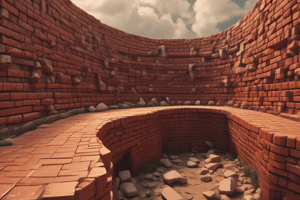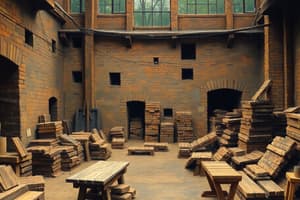Podcast
Questions and Answers
What is the minimum strength of concrete blocks?
What is the minimum strength of concrete blocks?
- 14MPa
- 10MPa
- 7MPa
- 3.5MPa (correct)
What is an advantage of using concrete bricks?
What is an advantage of using concrete bricks?
- They are made from all-natural materials
- They are free from defects due to human error
- They require no additional treatment
- They can be shaped into complex designs (correct)
What does FBX face brick provide?
What does FBX face brick provide?
- Durability and a high degree of conformity (correct)
- Lowest degree of size conformity
- Strength but poor color options
- Aesthetic appeal only
What is a disadvantage of concrete blocks?
What is a disadvantage of concrete blocks?
Which of the following is a characteristic of face brick aesthetic (FBA)?
Which of the following is a characteristic of face brick aesthetic (FBA)?
What is the maximum stone size that can be used in concrete bricks?
What is the maximum stone size that can be used in concrete bricks?
What is a key requirement when using hollow concrete blocks in earthquake-prone areas?
What is a key requirement when using hollow concrete blocks in earthquake-prone areas?
How are concrete bricks typically cured?
How are concrete bricks typically cured?
What is the primary use of stacked bond in construction?
What is the primary use of stacked bond in construction?
How is the compressive strength of a brick determined?
How is the compressive strength of a brick determined?
Which property of bricks is related to their response in harsh environments?
Which property of bricks is related to their response in harsh environments?
What causes efflorescence in bricks?
What causes efflorescence in bricks?
What aspect of bricks must be considered when calculating thermal movement?
What aspect of bricks must be considered when calculating thermal movement?
What is the primary purpose of drying clay bricks after forming?
What is the primary purpose of drying clay bricks after forming?
Which shaping system involves pushing clay through a long mold?
Which shaping system involves pushing clay through a long mold?
What is the firing temperature that clay bricks generally reach inside a kiln?
What is the firing temperature that clay bricks generally reach inside a kiln?
Which type of clay brick is primarily used for structural or load-bearing purposes?
Which type of clay brick is primarily used for structural or load-bearing purposes?
What is the characteristic of semi-dry bricks in the manufacturing process?
What is the characteristic of semi-dry bricks in the manufacturing process?
Which brick type is generally referred to as commons or stock bricks?
Which brick type is generally referred to as commons or stock bricks?
What does the term 'frogs' refer to in the context of pressed bricks?
What does the term 'frogs' refer to in the context of pressed bricks?
Which of the following is not a method of firing bricks?
Which of the following is not a method of firing bricks?
What is one of the main advantages of using perforated bricks?
What is one of the main advantages of using perforated bricks?
Which type of clay brick is specifically designed for aesthetic purposes?
Which type of clay brick is specifically designed for aesthetic purposes?
Which property of clay bricks helps to minimize heating and cooling costs in buildings?
Which property of clay bricks helps to minimize heating and cooling costs in buildings?
What are the five main processes in the manufacturing of clay bricks?
What are the five main processes in the manufacturing of clay bricks?
What is typically responsible for the reddish color of most clay bricks?
What is typically responsible for the reddish color of most clay bricks?
What is the primary factor affecting the compressive strength of clay bricks?
What is the primary factor affecting the compressive strength of clay bricks?
Which of the following processes involves altering the surface texture of facing bricks?
Which of the following processes involves altering the surface texture of facing bricks?
What is the significance of using the four natural elements in the composition of clay bricks?
What is the significance of using the four natural elements in the composition of clay bricks?
What is the typical cement:sand ratio for mortar?
What is the typical cement:sand ratio for mortar?
Which bond type alternates between headers and stretchers in each course?
Which bond type alternates between headers and stretchers in each course?
What minimum compressive strength is required for Mortar Class I at 28 days?
What minimum compressive strength is required for Mortar Class I at 28 days?
Which bonding pattern is often used for half brick and cavity walls?
Which bonding pattern is often used for half brick and cavity walls?
What is the requirement for vertical joints in loadbearing walls?
What is the requirement for vertical joints in loadbearing walls?
How much must laps be in brickwork bonding?
How much must laps be in brickwork bonding?
Which mortar class requires the use of 50 kg of cement bags and 1.25 m3 of sand?
Which mortar class requires the use of 50 kg of cement bags and 1.25 m3 of sand?
Which bonding pattern is considered the strongest option for brickwork?
Which bonding pattern is considered the strongest option for brickwork?
Flashcards are hidden until you start studying
Study Notes
Perforated Bricks
- Have one or more deep holes or depressions on one face, not penetrating through.
- Advantages include reduced manufacturing time, lighter weight, less material use, improved bonding, and better heat and noise insulation.
Clay Bricks
- Used for building, facing, aesthetics, flooring, and paving.
- Building bricks are structural materials; facing bricks are for aesthetics; flooring and paving bricks have high abrasion resistance.
- Very durable, fire-resistant, require little maintenance, non-combustible, and are poor heat conductors.
- Moderate insulation properties; minimize heating/cooling needs, reducing energy costs (Green Building).
- Compressive strength depends on clay composition, manufacturing method, and firing degree.
Clay Brick Manufacturing
- Made from a mixture of clay (different clays create different colors) and additives.
- Clays contain silica, alumina, lime, iron, manganese, sulfur, and phosphates in varying proportions.
- Iron oxide often causes reddish color.
- Unindurated material is clay; indurated is claystone; indurated and laminated is shale.
- Five main processes: obtaining material, mixing, shaping, drying, and firing.
- The final composition includes earth, wind, fire, and water.
- Facing bricks involve additional shaping stage work (colored sand or mechanical texturing).
Clay Brick Manufacturing: Obtaining Material and Mixing
- Clay is extracted, prepared, and mixed based on raw material and shaping process.
- Water content is controlled, ranging from very wet to relatively dry depending on the shaping process.
Clay Brick Manufacturing: Shaping Systems
- Extrusion and wire-cut: creates a clay ribbon pushed through a long mold; may have perforations but not frogs.
- Hand-made bricks: high-quality plastic clay thrown into molds; expensive.
- Semi-dry bricks: fine clay dust pressed repeatedly into molds; no drying needed; fairly regular shape.
- Pressed bricks: may have one or two frogs (cellular).
Clay Brick Manufacturing: Drying and Firing
- Drying is necessary for soft bricks unable to withstand stacking for firing (hand-made, soft-mud, high-moisture wire-cut bricks).
- Drying occurs in tunnels or chambers with regulated temperature to control shrinkage.
- Firing involves complex chemical and physical changes; temperature and atmosphere affect brick color.
- Kiln temperatures reach 1200°C.
- Four firing methods: clamp burning, intermittent kilns, continuous kilns, tunnel kilns.
Basic Types of Clay Bricks
- Non-face extra bricks (NFX): Used plastered or unplastered, under damp conditions (foundations).
- Non-face plaster bricks (NFP): General building work; require plastering or tiling. Also called commons or stock bricks.
- Common/Stock bricks: General building work; require plastering or tiling.
- Engineering units (E): For structural or load-bearing purposes; manufactured to agreed compressive strength (above 14 MPa to over 50 MPa).
- Face brick extra (FBX): Selected for durability and high conformity to size, shape, and color; compressive strength > 50 MPa.
- Face brick standard (FBS): Durable and uniform in size and shape.
- Face brick aesthetic (FBA): Selected or produced for durability and aesthetic effect from size, shape, or color.
Concrete Bricks
- Controlled manufacture: mixture of cement, sand, aggregate, and additives (coloring agents).
- Mixture pressed/vibrated into molds; cured in steam chambers or air.
- Regular in size and color; minimum strength of solid units is 7 MPa; maximum stone size is 13.2 mm.
Concrete Blocks
- Similar to concrete bricks but larger (usually 390mm x 190mm x 90mm).
- Used for internal and external walls; plastering recommended for moisture protection.
- Less expensive than clay bricks and allow for faster construction.
- Minimum strength for hollow blocks is 3.5 MPa; stone size should not exceed 1/3 of the maximum hollow unit shell.
Concrete Bricks and Blocks: Advantages and Disadvantages
- Advantages: Readily available ingredients, no heating process (economical), castable to any shape, free from flaws (quality control), generally strong.
- Disadvantages: Generally require plastering and painting, may be subject to water seepage, requires internal reinforcement (hollow blocks, earthquake zones), large blocks are heavy, potential plumbing issues (pipe leaks).
Mortar Strength Requirements and Mix Proportions
- Mortar classes I and II have minimum compressive strengths of 14.5 MPa and 7 MPa at 28 days, respectively.
- Material quantities per cubic meter of mortar (excluding wastage) are specified for each class using 50kg cement bags.
- Typical cement:sand ratio is 1:3
Building with Bricks: Brick Ties and Brick Reinforcing
- Information is present but lacks specifics in the provided text.
Building with Bricks: Bonding Patterns
- Stretcher bond, English bond, Flemish bond, and stacked bond are mentioned. Details are provided in the subsequent sections.
Building with Bricks: Brick Bonding
- Stability is key; use a recognized pattern/bond.
- Bond affects appearance.
- Vertical joints in load-bearing walls must not extend into the next course; bricks may need cutting.
- Cut bricks should not be less than half a brick length.
- Laps must not be less than a quarter of the brick length.
Bonding Patterns: Stretcher Bond
- Longer side faces the outside wall; used for half-brick walls and cavity walls.
Bonding Patterns: English Bond
- Very strong bond; alternating courses of stretchers and headers; used for one-brick walls.
Bonding Patterns: Flemish Bond
- Alternating headers and stretchers in each course; not as strong as English bond.
Bonding Patterns: Stacked Bond
- Used for non-load-bearing walls; often includes brick reinforcing; mostly for aesthetics.
Properties of Bricks
- Water absorption: Percentage increase in a dry brick's weight when saturated.
- Compressive strength: Mean of 10 crushing tests (falling load/gross area).
- Frost resistance: Determined by pore structure (percentage of fine pores); bricks with low porosity and water absorption are better for harsh environments.
- Soluble salt content: Can cause efflorescence (powdery deposits); forms with water ingress; salt is carried to the surface when water evaporates.
- Thermal movement: Bricks expand when warm and shrink when cooled; expansion of brickwork must be considered.
- Moisture movement: Clay bricks expand on cooling from the kiln (some water molecules re-attach); this is irreversible unless re-fired.
Studying That Suits You
Use AI to generate personalized quizzes and flashcards to suit your learning preferences.




